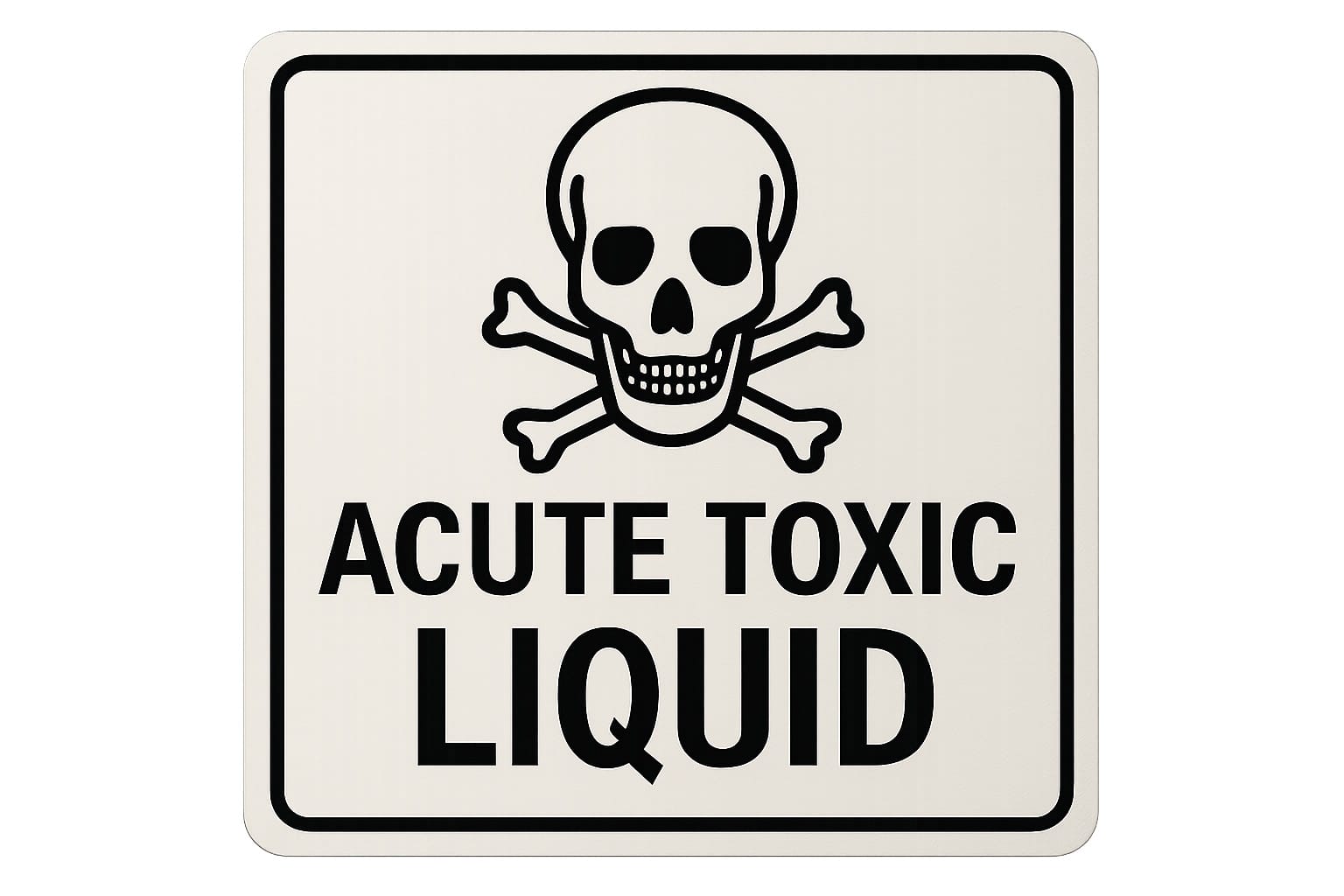Understanding the Hazards: Life-Saving Labels for Toxic Liquids
Acute toxic liquid labels are standardized warning systems required by OSHA that communicate potentially life-threatening chemical hazards to workers and handlers. These labels follow the Globally Harmonized System (GHS) for consistent hazard communication worldwide.
For those needing quick information about acute toxic liquid labels:
| Element | Requirement |
|---|---|
| Pictogram | Skull and crossbones in red diamond (Categories 1-3) |
| Signal Word | “Danger” (Categories 1-3) or “Warning” (Category 4) |
| Required Information | Product identifier, hazard statements, precautionary statements, supplier information |
| Color | White background with red borders around pictograms |
| Format | Must be clearly legible, durable, and prominently displayed |
According to OSHA, acute toxic chemicals are responsible for over 10,000 reported workplace injuries and illnesses annually in the United States. Proper labeling isn’t just about compliance—it’s about saving lives.
Acute toxic liquids are classified into categories based on their LD50/LC50 values (lethal dose/concentration affecting 50% of test subjects):
- Category 1: Extremely toxic (oral LD50 < 5 mg/kg)
- Category 2: Highly toxic (oral LD50 5-50 mg/kg)
- Category 3: Toxic (oral LD50 50-300 mg/kg)
- Category 4: Harmful (oral LD50 300-2000 mg/kg)
- Category 5: May be harmful (oral LD50 2000-5000 mg/kg)
The use of standardized GHS labels has been shown to improve hazard recognition by up to 40% among workers compared to non-standardized labels. This clarity is critical when every second counts during an emergency.
Whether you’re a safety manager, packaging specialist, or chemical manufacturer, understanding these labeling requirements is essential for workplace safety and regulatory compliance.
Understanding the Acute Toxic Liquid Label Rules
The regulatory framework for acute toxic liquid labeling might initially seem complex, but it’s designed with a clear purpose: keeping people safe.
The Globally Harmonized System (GHS), which OSHA adopted through their Hazard Communication Standard, gives us a universal “language” for classifying and labeling hazardous chemicals. This standardization helps everyone from lab technicians to warehouse workers immediately recognize dangers.
What Is an Acute Toxic Liquid?
Simply put, an acute toxic liquid is something that can seriously harm or kill you after just one exposure or multiple exposures within a 24-hour period. Think of it as the “fast-acting” category of dangerous substances.
These toxins can enter your body in three main ways:
- Through your mouth (oral exposure)
- Through your skin (dermal exposure)
- Through your lungs (inhalation exposure)
Scientists measure how dangerous these substances are using what they call LD50 values (the Lethal Dose that affects 50% of test subjects) for substances absorbed through mouth or skin, and LC50 values (Lethal Concentration) for substances we breathe in.

Why the Acute Toxic Liquid Label Matters for Health & Compliance
Acute toxic liquid labels serve two crucial purposes – protecting people and keeping businesses compliant.
From a health standpoint, these labels are literal lifesavers. They:
- Warn workers about potentially deadly hazards before they handle chemicals
- Provide guidance on proper handling to prevent accidents
- Give emergency responders critical information during incidents
- Offer immediate first-aid instructions when seconds count
The latest scientific research on GHS Rev.10 continues to refine these standards based on real-world effectiveness and emerging hazards. Staying current with these evolving standards isn’t just good business—it’s a moral imperative.
Designing Compliant Acute Toxic Liquid Labels & Best Practices
Creating effective acute toxic liquid labels isn’t just about checking regulatory boxes—it’s about saving lives through clear communication. Under OSHA’s Hazard Communication Standard (aligned with GHS), all hazardous chemical labels need six essential elements working together to protect workers:
- Product Identifier: The specific chemical name, code, or batch number that identifies what’s inside
- Signal Word: Either “Danger” (for more severe hazards) or “Warning” (for less severe)
- Hazard Pictogram(s): Those eye-catching symbols in red diamonds that communicate hazards at a glance
- Hazard Statement(s): Straightforward phrases describing exactly what harm the chemical can cause
- Precautionary Statement(s): Practical guidance on how to stay safe when handling the substance
- Supplier Information: Who made it, where they’re located, and how to contact them in an emergency
For acute toxic liquids, the label requirements change based on just how dangerous the substance really is:
When dealing with Categories 1-3 (the highly toxic ones), your label needs the skull and crossbones pictogram paired with the signal word “Danger.” The hazard statements get right to the point with phrases like “Fatal if swallowed” for Categories 1-2 or “Toxic if swallowed” for Category 3. Similar statements apply for skin contact and inhalation hazards.
For the less severe Category 4 substances, the exclamation mark pictogram and signal word “Warning” are used instead, with more moderate hazard statements like “Harmful if swallowed.”
Here’s something many people miss: when your mixture contains ingredients with unknown acute toxicity at concentrations of 1% or more, you must add a statement like “10% of the mixture consists of ingredient(s) of unknown acute toxicity.” This percentage needs to be calculated separately for each exposure route.
Building an Acute Toxic Liquid Label Step-by-Step
Creating an acute toxic liquid label that works in the real world takes more than just knowing the rules—it requires a thoughtful approach. Here’s how to build one that protects workers and meets compliance:
Start by determining the toxicity category based on those critical LD50/LC50 values. This scientific foundation drives everything else on your label. Then select the appropriate pictogram—skull and crossbones for Categories 1-3 or exclamation mark for Category 4. Multiple hazards might require multiple pictograms.
Next, assign the correct signal word. Only one can appear on a label, so if both “Danger” and “Warning” would apply, “Danger” always wins. Then add appropriate hazard statements for each exposure route. You can streamline these when possible—for example, “Fatal if swallowed or in contact with skin” combines two hazards clearly.
Don’t forget to include precautionary statements covering all bases: prevention (“Do not eat, drink or smoke when using this product”), response (“IF SWALLOWED: Immediately call a POISON CENTER/doctor”), storage (“Store locked up”), and disposal guidance. Finally, add the product identifier and supplier information, plus any unknown toxicity statement if needed.
The physical design matters just as much as the content. Your label must be legible (with text large enough to read easily), durable (able to withstand the conditions where it will be used), and use high-contrast colors (black text on white background works best).
Label Acute Toxics Correctly
Proper acute toxic liquid labeling isn’t just about checking boxes on a compliance form—it’s about protecting lives. These labels serve as the first warning system against chemical exposures that could lead to serious injury or worse.
Throughout our journey in this guide, we’ve explored the critical aspects of toxic liquid labeling:
- How acute toxic liquids are classified based on their danger level
- The essential elements required on every GHS and OSHA-compliant label
- A practical approach to creating labels that meet all requirements
- The important distinctions between transportation and workplace labeling
If there’s one thing to remember, it’s that details matter. Acute toxic liquid labels with the skull and crossbones pictogram aren’t just scary-looking warnings—they’re carefully designed communication tools that could save someone’s life.
The most successful safety programs understand that:
- Proper categorization based on LD50/LC50 values is the foundation of effective labeling
- Clear, legible labels with all six required elements (product identifier, signal word, pictograms, hazard statements, precautionary statements, and supplier information) are non-negotiable
- Labels must be designed with real-world conditions in mind—they need to stay put and stay readable
- Different contexts (transport vs. workplace) have different labeling needs, and both must be addressed
For more information about industrial durable labels that stand up to challenging environments, check out our specialized solutions.
